How Notion Used Community to Scale to 20M+ Users How Notion Used Community to Scale to 20M+ Users
Length: • 10 mins
Annotated by omar
omar: There are a lot of lessons here for why a community program is critical to product growth and how to start a community program. This article discusses how Notion, an enterprise software company that also operates as a viral consumer product, leveraged community to scale and reach 20 million users. Notion sells into big companies such as Figma and Pixar, and acts as a company wiki, but also captivates Gen Z and became a TikTok sensation, with young people using it for homework planners, content calendars and vision boards. Notion's secret weapon in scaling was a Community function that the company formalized to include an online application and Ambassador program. Notion's Head of Community, Ben Lang, built a group of passionate ambassadors who ran their own Notion sub-reddits, YouTube channels and wrote books. They receive early access to new features that they test and give feedback on to inform product design.
Speaking with Notion's Head of Community on Notion's Growth Playbook
Weekly writing about how technology shapes humanity, and vice versa. If you haven’t subscribed, join 45,000 weekly readers by subscribing here:
How Notion Used Community to Scale to 20M+ Users
I love good design.
I could spend all day talking about branding, product design, and my adoration for Jony Ive. When it comes to building consumer tech products, I often think of this quote from Steve Jobs: “It’s in Apple’s DNA that technology alone is not enough—it’s technology married with liberal arts, married with the humanities, that yields us the results that make our heart sing.”
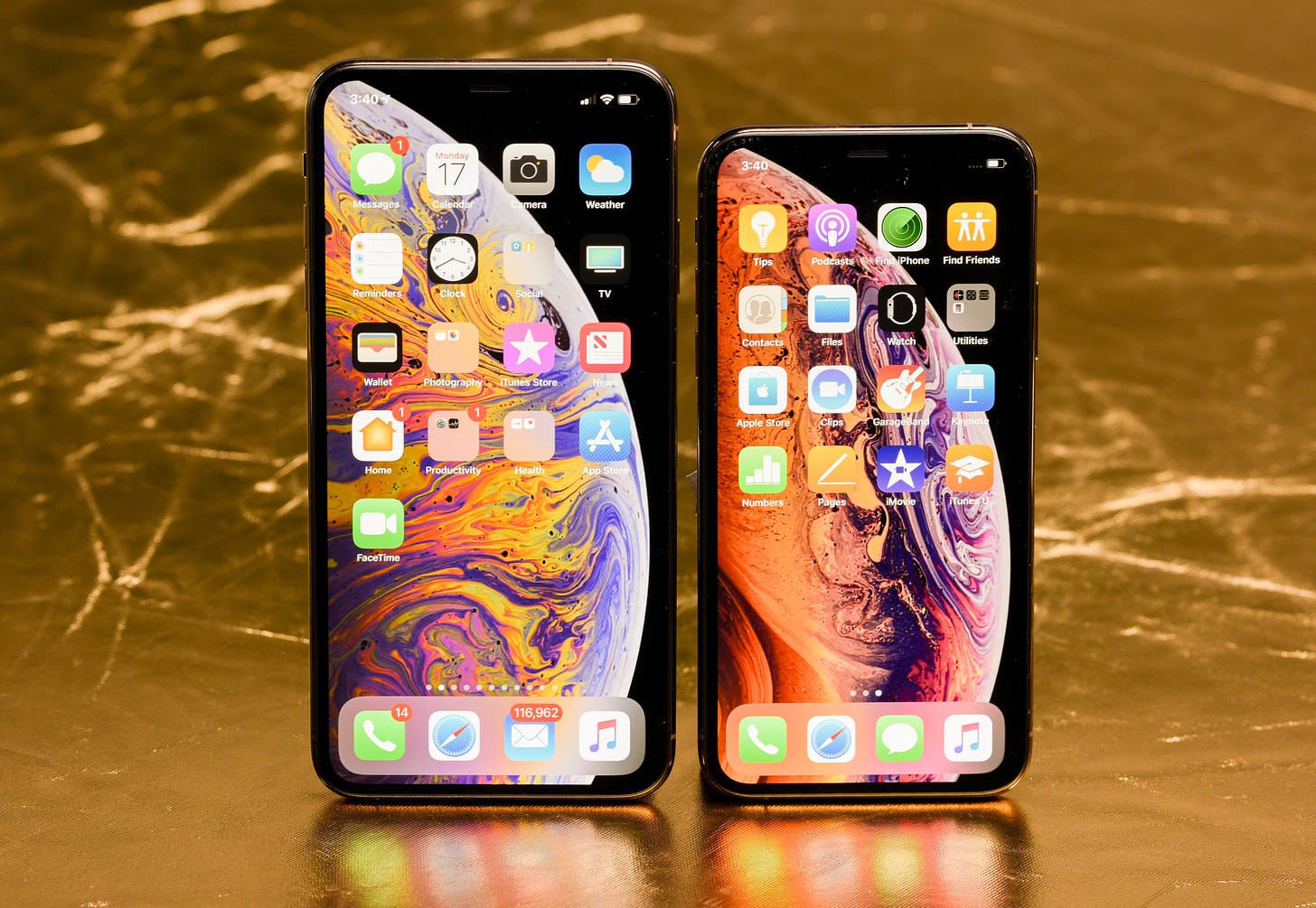
Even Bill Gates, Jobs’s arch rival, admired Apple’s design sensibility—after Jobs’s death, Gates told 60 Minutes: “[Steve] knew about brand—in a very positive sense. He had an intuitive sense for marketing that was amazing.”
I have a soft-spot for tech products that feel like a work of art, and Notion is such a product. It’s gorgeous, sleek, intuitive. My friend Sarah Cannon once wrote of it, “I deeply admire artists who get to the essence of things...Notion’s product reflects a philosophy of minimalism. The product facilitates a singular focus on the things that matter.”
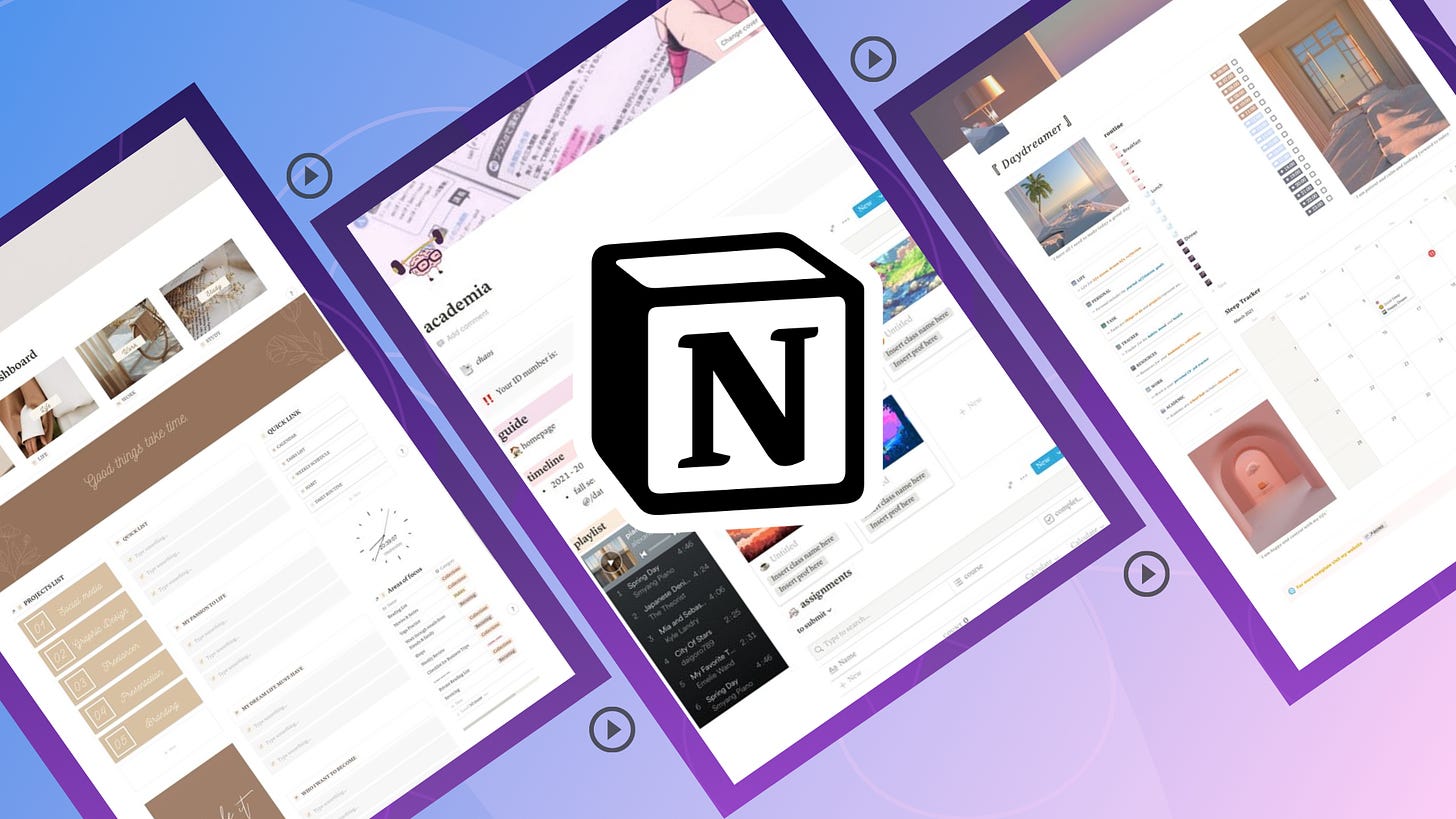
I use Notion to run my day-to-day life—writing to-do lists, tracking startups, outlining Digital Native pieces. When my dad asked me over Christmas why Taylor Swift is so great, I wrote him “An Education in Taylor Swift” in Notion. (It’s publicly available here if you’re in need of indoctrination.)
Notion is a fascinating case study in versatility. On the one hand, Notion is an enterprise software company that sells into big companies. Customers include Pixar and Figma. My partner works at Faire, now about 1,200 employees, and Faire runs on Notion; Notion is its central nervous system. In a world of global, distributed teams, Notion offers a source of truth and acts as a company wiki.
Yet Notion is also a viral consumer product. Somehow, a productivity software tool captured the imagination of Gen Z and became something of a TikTok sensation. Young people use Notion for homework planners, content calendars, Pinterest-like vision boards. And they aren’t shy about broadcasting their love for the product:
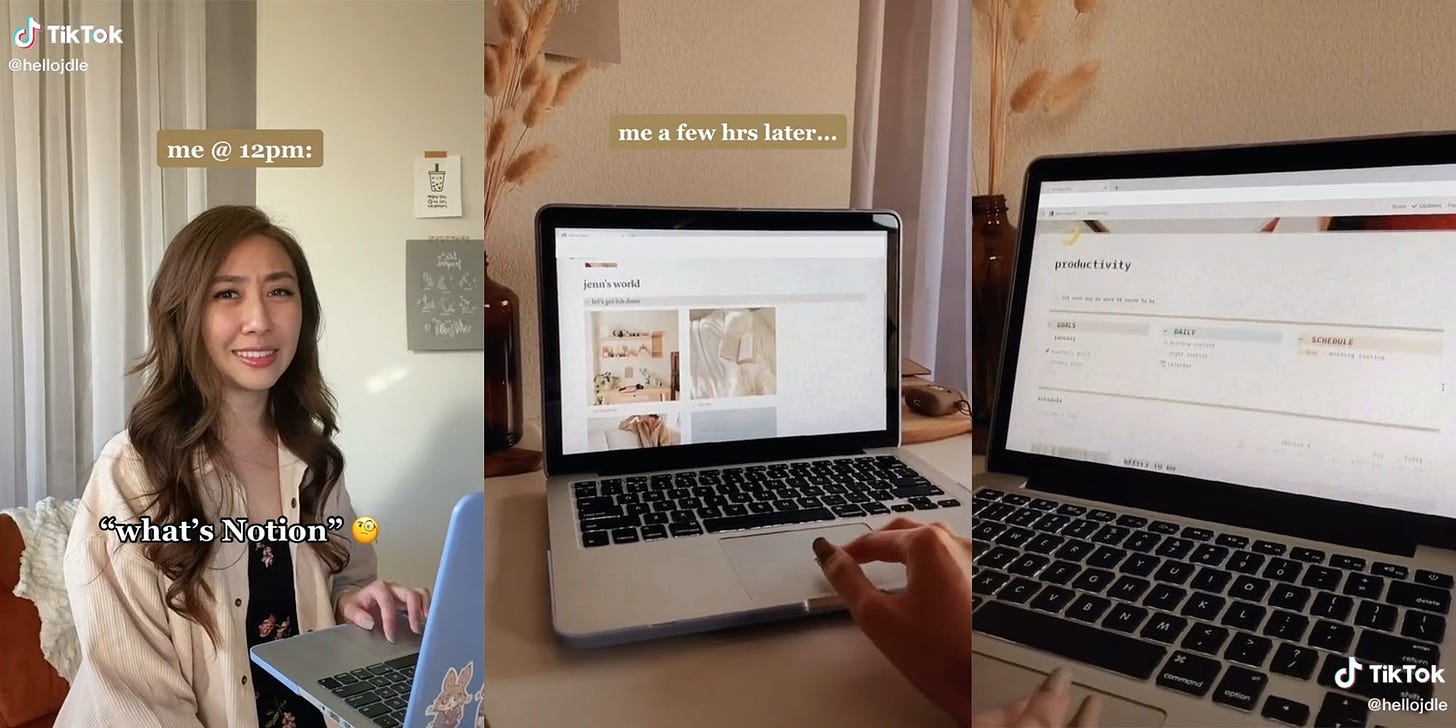
In addition to product design, I have another great love: understanding how startups grow. I geek out about brand, marketing, and virality. And Notion’s growth playbook is one of the more savvy and unique out there.
Notion’s secret weapon is a function that many startups overlook: Community.
At a time when distribution is more difficult than ever for entrepreneurs—post-ATT CAC headwinds, Big Tech incumbents, AI shifting how we interface with companies—Community offers a new and underutilized distribution channel.
I spoke to Ben Lang, Notion’s Head of Community, to understand how Notion has leveraged community to scale and how other startups can replicate its success. This week’s piece stems from our conversation:
- How Notion learned the importance of Community (and how Ben got hired)
- Getting started: What does Community even mean?
- Building out the Community function
- How Notion structures Community today
- How Community informs Product 🔁
Let’s dive in, starting with the origin story of Notion’s Community function.
How Notion learned the importance of Community
Ben Lang first found Notion on Product Hunt.
A former founder himself, Ben was working at another startup when he stumbled upon Notion. The product immediately captured his imagination.
Ben began to spend his free time evangelizing Notion: he built a website where people could share Notion templates; he started to tweet about Notion; he launched a Facebook group for Notion enthusiasts to interact. He found himself spending his evenings and weekends on Notion—all for free, out of a genuine love for the product.
A few months in, Ben’s efforts caught the attention of Camille Ricketts, who had just joined Notion as its Head of Marketing. Camille tapped Ben to start working more formally with the startup—then still less than 15 employees—and over time Ben’s role morphed into a full-time gig. Ben’s title became Head of Community, and Notion formalized Community as an internal function.
Community became a key part of Notion’s growth strategy. One interesting takeaway: it all started with one enthusiastic Notion user. To find the person to lead its Community efforts, Notion didn’t hire a headhunter or write a formal job spec. Instead, it turned to the most logical place: its own community.
Getting started: What does Community even mean?
“Community” has become something of a buzzword in Silicon Valley, but the word is broad and amorphous. It’s...squishy. When I ask Ben to define what Community means to him, he answers: “Community is a group of people with shared values and interests.” Fair enough, but let’s make that more tangible by examining how Notion jumpstarted its Community function:
The first thing Ben did was set out to build an Ambassador program. He had a hypothesis: if he was crazy enough to spend his evenings and weekends doing free stuff for Notion, other people were probably equally crazy. His job was to find them.
By following the bread crumbs of Facebook groups and Twitter accounts and Reddit usernames, Ben began to locate his fellow enthusiasts. They were in Tokyo and Seoul, Melbourne and Berlin—scattered across the globe, but all anchored by a deep love for the product. One user in Korea had created a lengthy guide to using Notion. A user in Japan had been hosting meet-ups in his city.
Ben began to assemble the power users for Notion’s new Ambassador program. His key questions to answer:
- What motivates these people?
- What inspires them?
- How can we leverage them to grow?
Building out the Community function
Soon, the Notion team built out an online application for Ambassadors. (It still exists here.) The team optimized for two things: 1) Passion, and 2) Geography. Notion wanted to find a mix of people in far-flung cities and countries, who all shared a deep understanding of the product and an organic love for telling people about it.
When it came to vetting applicants, Ben and his team asked about community-building experience. Had the person started a YouTube channel, launched a newsletter, hosted an event? People who had built followings or been content creators were the ideal profile, as they had a demonstrated knack for growing and cultivating an audience.
There was one caveat: Ambassadors wouldn’t be compensated. The Notion team wanted to be clear that Ambassadors shouldn’t be doing this for money, which could warp authenticity, but out of genuine love for Notion. This was a volunteer program.
Once Notion had its first cohort of Ambassadors, they let them loose. The team tried hard to not be overly prescriptive, encouraging Ambassadors to take things in the directions they wanted. Some Ambassadors launched YouTube channels dedicated to Notion, with the top channels reaching 50K+ subscribers.
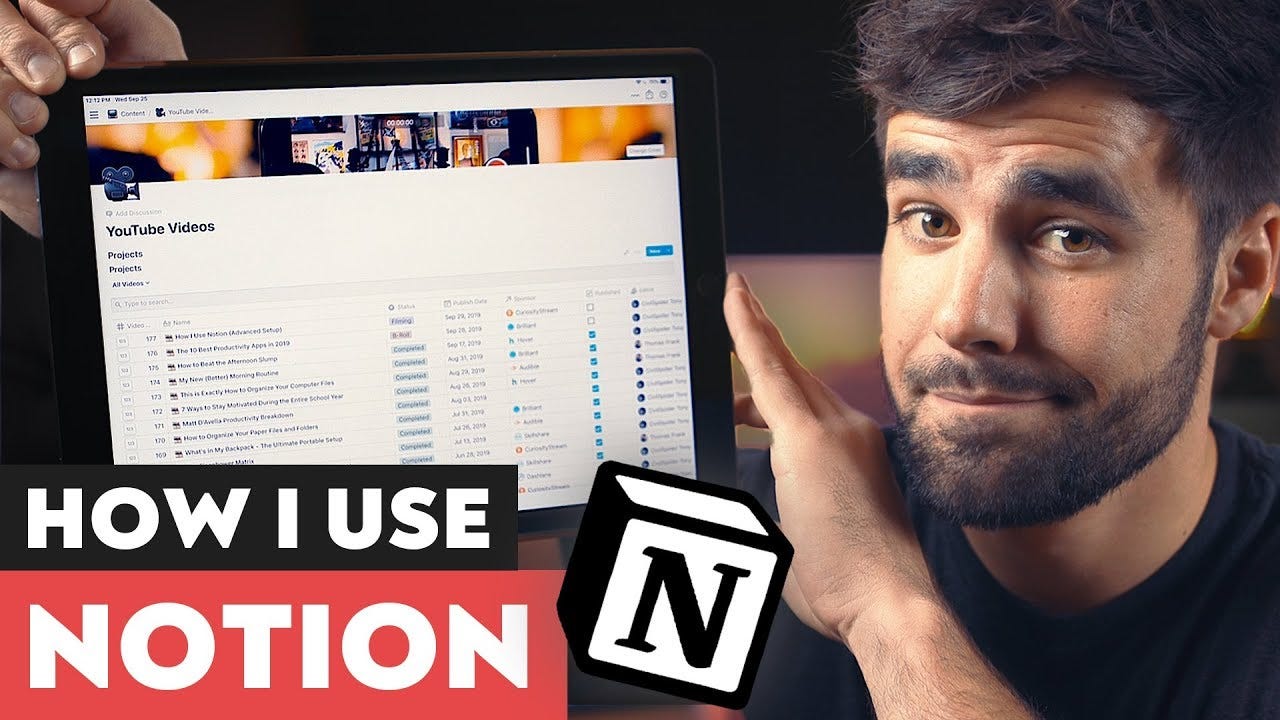
Other Ambassadors wrote books on Notion (this turned out to be especially popular in Japan and Korea). Many Ambassadors hosted events, meet-ups in cities like London, Paris, and Hong Kong that ranged from 10 to 300 people.
The strategy worked. Facebook Groups swelled in size; Notion Vietnam, for instance, has 226K members. A few Ambassadors banded together to start r/Notion, the Notion Community’s formal subreddit, which has grown to 280K members. Those Ambassadors still manage the subreddit today.
To formalize things even further, Ben and his team built Notion.com/Community as a community resource.

Here, Notion users could learn how to get involved in the community:
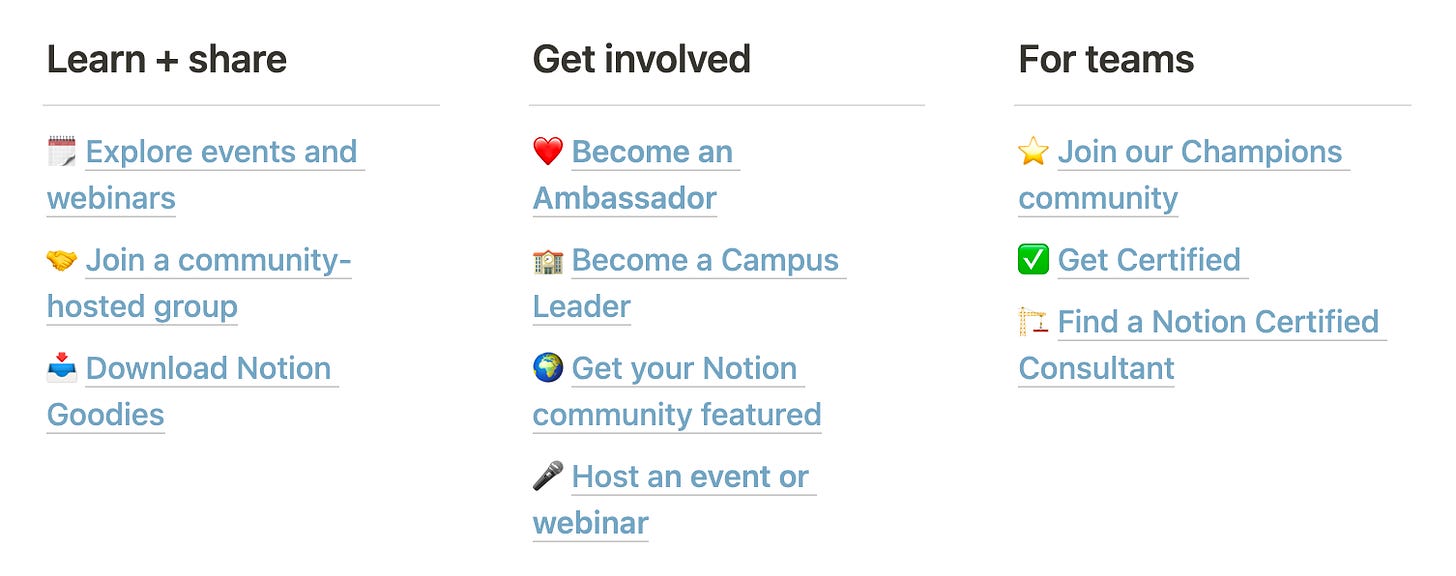
Users could join community groups, explore webinars, and discover events happening around the world:

Today, Notion Ambassadors and Campus Leaders host about 60 events a month. Every day, there are at least two events taking place somewhere in the world—events that are completely free and completely organic, hosted not by Notion employees but by Notion’s own users.
How Notion structures Community today
Notion’s Community team is lean: it’s just three people, and everyone wears many hats. Francisco Cruz Mendoza and Emma Yee Yick are both experienced community leaders, helping drive the management, operations, and strategy of the team’s various programs. Community is a relationship-driven function, so members of the team are often in the weeds, meeting users and gathering feedback.
The Notion Community stack looks something like this:
- Notion, of course, as a central hub for the team: individual Notion workspaces give members of community programs a space to collaborate together
- Slack spaces and, more recently, Circle spaces for managing different Notion-run programs and for managing Ambassadors
- SwagUp for sending swag at scale
- Tremendous for sending out grants to allow people to host events or travel to meet-ups
- Sanity for customizable data tracking and dashboards
- Threado to automate workflows on the community management side
The Notion Community team also hired a few contractors to help test and scale influencer marketing. The goal was to find creators across various domains—education, technology, startups, productivity. These creators could speak to the breadth of Notion’s use cases.
Notion paid such creators to make TikTok and YouTube content about how they used Notion. It was important that the creators were actual Notion users themselves—and many creators were, using Notion for planning their own video scripts and production schedules.
The influencer strategy was a success: smaller creators saw bigger creators using Notion and talking about it, and began to create organic content on their own. This led to Notion becoming something of a TikTok sensation in 2021:



This virality introduced the product to a new generation of users and to a breadth of new use cases. Influencer marketing eventually spun off into its own function and Notion hired a dedicated leader to scale the channel.
How Community informs Product
One key benefit of Community: the function creates a direct connection with a product’s most enthusiastic users. Savvy companies listen to their power users and learn from them about their own product. (One trap to avoid falling into: building too much for your top 1% of users so that you begin to isolate the other 99%.)
Early on, Notion’s Community efforts began to inform the Product org. Ben and his team were struck by the creative ways people were using Notion—ways they would have never dreamt up. People were using Notion to track their dating lives, to organize recipes, to plan weddings.
The team realized they needed to productize Notion’s diversity of use cases: their work had revealed that Notion had a blank page problem for new users. In other words, as a new user, it was intimidating to know how to begin using Notion. New users needed some form of education, some form of inspiration.
The Notion team responded by building a template gallery. Here, users could create open-sourced templates that other users could duplicate for their own use.
This was a game-changer: usage exploded, and onboarding was simpler and faster for new users. Notion’s template gallery today shows wide-ranging ways the product can be used—here, for instance, users have created a New Year’s Vision Board template and a Habit Tracker:
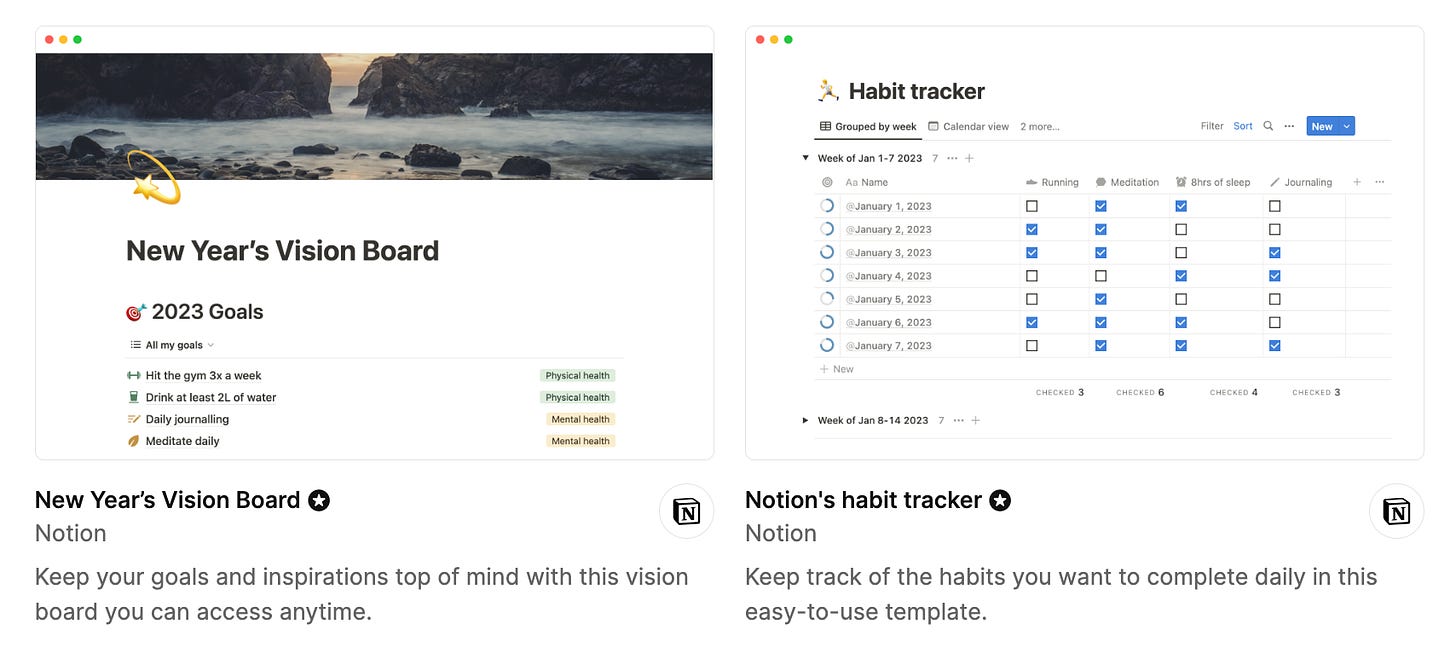
Notion’s template gallery allows for free and paid listings. Notion doesn’t have monetization built in as a function today, but the company does allow people to link out to sites like Gumroad for paid templates.
Naturally, third-party marketplaces have popped up. If you search “Notion templates” on Etsy, you get hits for people selling their creations for $10 or $20.
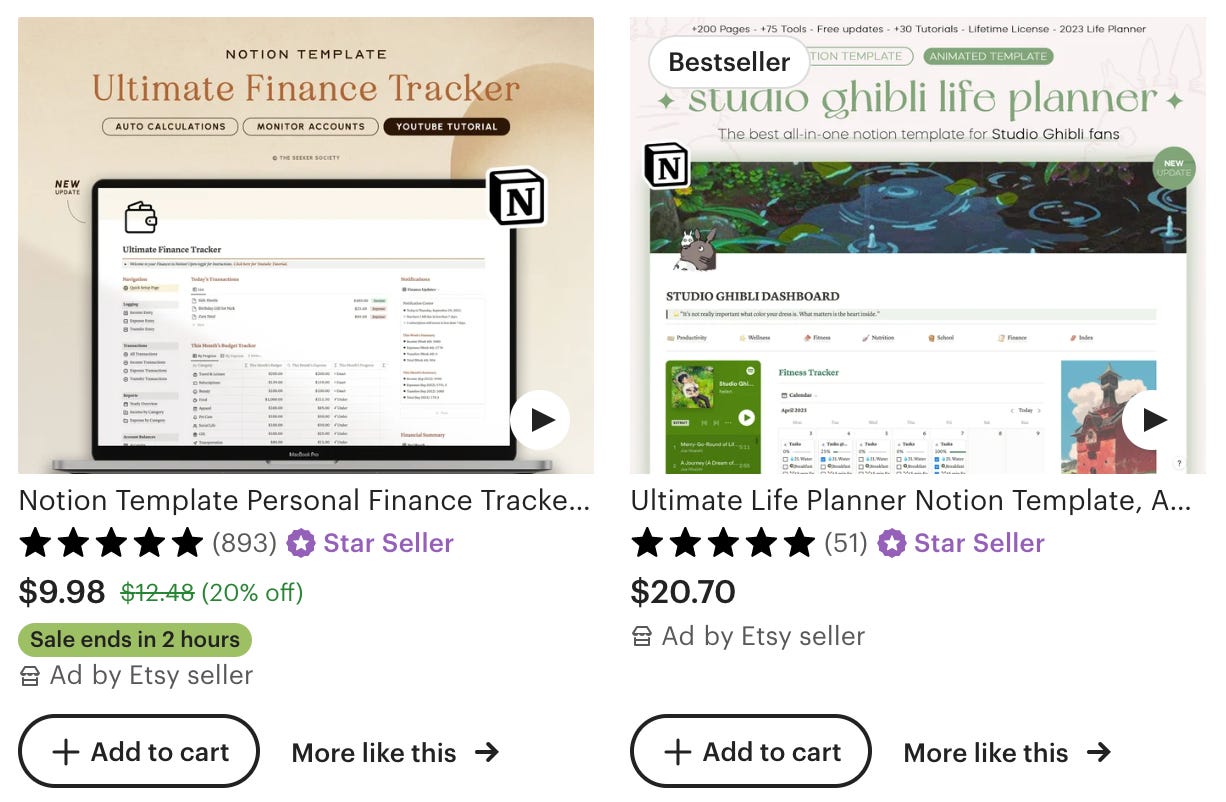
Dedicated sites have even sprung up. Prototion is a site for buying and selling Notion templates, like this TikTok creator dashboard:
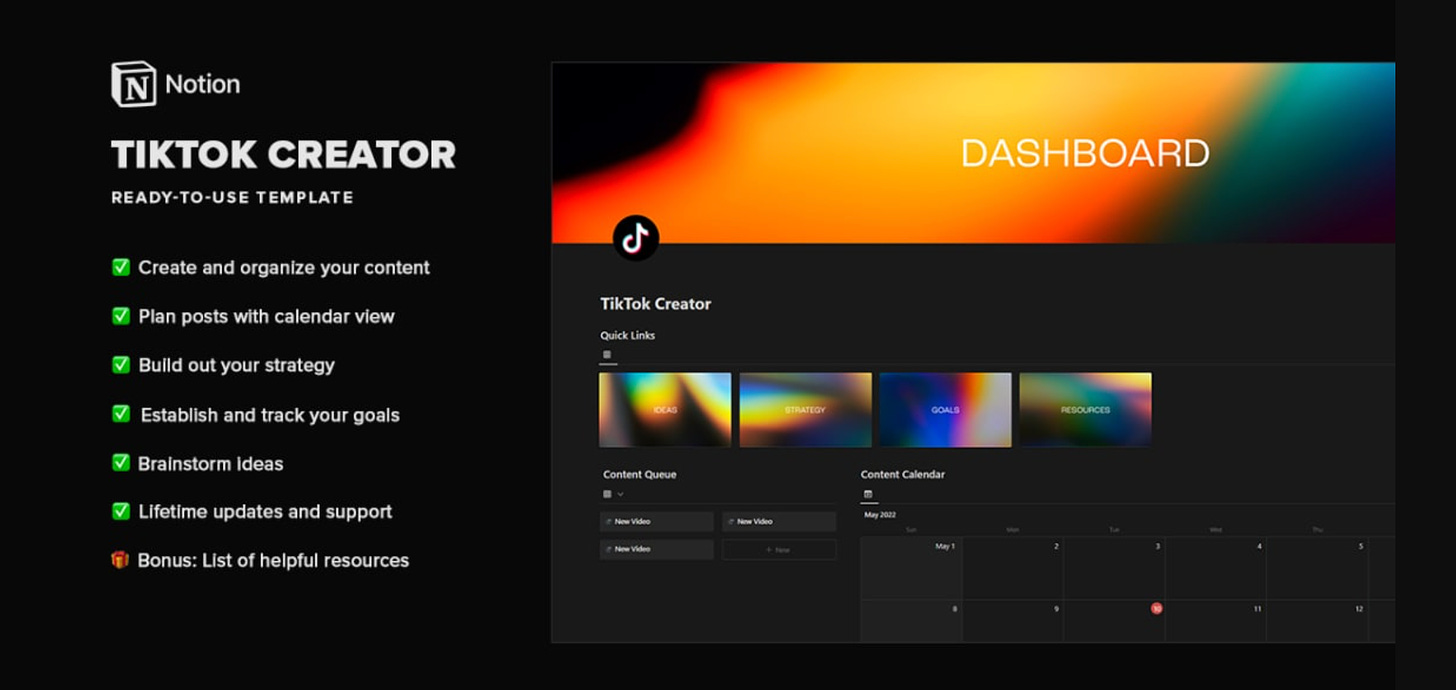
One way that Notion’s Community team has structured its relationship to Product: Ambassadors receive early access to some new features. The Product team digests feedback, then uses that feedback to improve the feature before releasing it broadly to all users. The team also replicated this with other programs run by the Community team, like with their customer Champions program.
I asked Ben to name an example of a time he learned a creative use case from a member of the community. He mentions an example from this week. Notion has a new feature—button functionality that lets you click a button to take an action. One innovative user began using the button functionality in a water tracker he built. Every time he clicks “8 oz glass of water,” his page updates with the amount of water he’s consumed that day; he uses this to make sure he’s drinking enough fluids.
According to Ben, this sort of thing happens all the time—the community teaches Notion’s team about how people are using its new features, which informs how Notion builds and releases products.
Final Thoughts: “The squishiness of it is the magic.”
When I asked Ben about how Community changes as a company scales, he’s clear that Community needs to be treated differently than other channels:
The question is—how do you maintain purity and authenticity with scale? If you turn Community into a sales engine, that feels inauthentic and—bam—you lose what makes it special. Community is different than a paid marketing channel or an enterprise sales motion. A lot of this is relationships and people—it’s not transactional like sales or marketing. The squishiness is the magic.
This is what makes mastering Community difficult: every company has a different community—different tastes and preferences among its userbase. A productivity app is different from an e-commerce marketplace, which is different from an MMO. Startups have to listen closely to users to 1) understand what users want from the product, and 2) leverage that feedback into fine-tuning the product roadmap and the go-to-market motion. Community infrastructure tools like Common Room and Commsor have emerged to help companies keep a pulse on their users across the many silos they live in—Discord, Reddit, Twitter, Facebook, GitHub.
Ben is clear about another challenge Community faces in scaling: proving ROI. Eventually, leadership will want to see that dollars flowing into Community are showing a return. But how can you prove value when things are so opaque? A successful Community strategy requires leadership that understands the uniqueness of the channel and doesn’t overly-quantify a highly-qualitative function.
Community is less about pouring spend into an acquisition channel, and more about listening to users, leaning in to what they want, and using feedback to inform product decisions.
There are ways to systemize Community, sure: a template gallery (even one that allows power users to monetize) can be a powerful tool for new users and for use case discovery; a well-run Ambassador program lets a company maintain some control over and understanding of its most fervent users; and structured sessions with power users to collect product feedback and fine-tune the product roadmap are important parts of the Product org.
But it’s important to treat Community differently. In our borderless, 24/7 digital world, Community is always on—it’s a hive buzzing with constant energy and activity. That hive can be a powerful tool for customer acquisition and for building product, but it takes time to understand the hive, to keep it happy, and to scale it. This makes Community unique as an acquisition channel. One sentence Ben said resonated with me: “Community is something that’s so hard to build and so easy to lose.” Community’s magic is in its inherent fragility.
Related Digital Native Pieces
- Viral Growth: How to Keep Lightning in the Bottle ⚡️
- The Rise of Cash App
- CAC: Customer Acquisition Chaos
- Revisiting Lifetime Value and Customer Acquisition
- Enterprise Software Is Dead. Long Live Enterprise Software.
Thanks for reading! Subscribe here to receive Digital Native in your inbox each week: